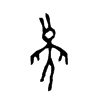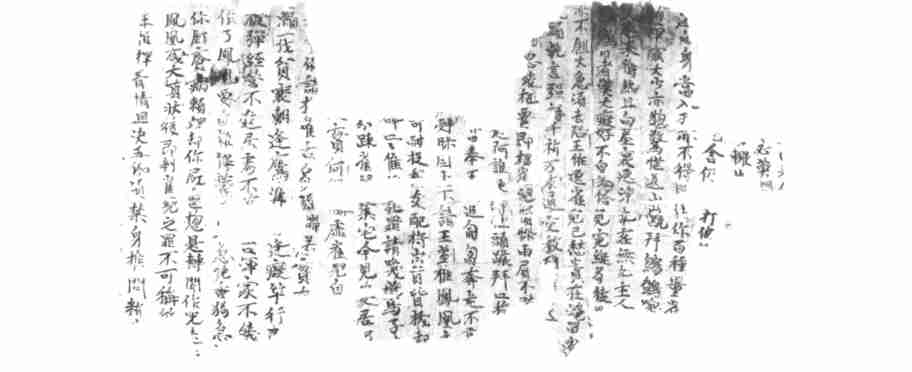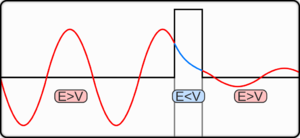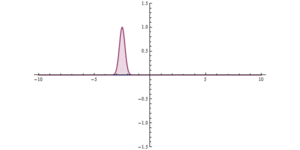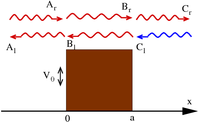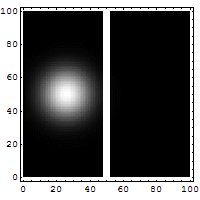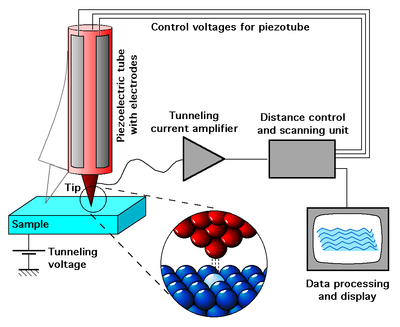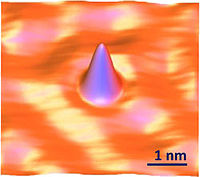雖然 AlphaGo 已成世界圍棋冠軍, AlphaGo 的創造者也不曾宣稱它的『深度學習神經網路』具有『主體性』。就像人們即使感覺那個箱內電子的『穿隧效應』很玄,同樣不會認為它擁有『自由意志』的哩︰
《説文解字》:燕,玄鳥也。籋口,布翄,枝尾。象形。凡燕之屬皆从燕。
玄鳥生商
春分玄鳥降,湯之先祖有娀氏女簡狄配高辛氏帝,帝率與之祈于郊而生契。
《詩經‧商頌‧玄鳥》
天命玄鳥,降而生商,宅殷土芒芒。古帝命武湯,正域彼四方。方命厥後,奄有九有。商之先後,受命不殆,在武丁孫子。武丁孫子,武王靡不勝。龍旂十乘,大糦是承。邦畿千里,維民所止,肇域彼四海。四海來假,來假祁祁。景員維河。殷受命鹹宜,百祿是何。
《敦煌變文集‧燕子賦》
燕子曰︰人急燒香,狗急驀牆。
如果說狗急跳牆,那狗也可能會遇到『跳不過的』牆,可是這個『電子』說來是更玄的啊!它跳得過那個跳不過的牆!!
一九二七年丹麥的大物理學家尼爾斯‧波耳 Niels Bohr 在量子力學中,提出了『互補性原理』complementarity principle ︰
微觀物體可能具有波動性或粒子性,有時會表現出波動性,有時會表現出粒子性。當描述微觀物體的量子行為時,必須同時思考其波動性與粒子性。
也就是說『電子』要當作『粒子』講或當作『波動』講,得看具體情況而定,像在『陰陽互補』的未定之天。因為『量子系統』滿足的『波動方程式』是個『機率波』,所以那個『箱內電子』就有機會在『箱外』被發現,並將此效應命名為『量子穿隧效應』Quantum tunnelling effect 。
『掃描式隧道顯微鏡』 STM scanning tunneling microscope 是一種利用『量子穿隧效應』探測物質表面結構的儀器。這個儀器在一九八一年於瑞士 IBM 蘇黎世實驗室,由德國物理學家格爾德‧賓寧 Gerd Binnig 和瑞士德裔物理學家海因里希‧羅雷爾 Heinrich Rohrer 所發明,兩人因此於一九八六年獲得諾貝爾物理學獎的殊榮。這個厲害的設備,可以讓科學家『觀察』與『定位』『單個原子』,是同等級的『原子顯微鏡』中之『分辨率』的『極高等級』。假使在『四度 ![]() 』的低溫下,可以利用『探針尖端』精確的『操縱原子』,故為『奈米科技』中的重要『量測儀器』和『加工工具』。
』的低溫下,可以利用『探針尖端』精確的『操縱原子』,故為『奈米科技』中的重要『量測儀器』和『加工工具』。
左圖是單獨鈷原子在 ![]() 表面上的形貌影像。
表面上的形貌影像。
─── 摘自《箱內電子!!》
如果說『客觀顏色』指
![]()
,由於『相同光譜』定然產生『相同三刺激值』,卻可被『人眼』看成『不同顏色』,所以人類之『色彩知覺』是『主觀』的。豈非奇怪耶?為什麼不可以是
![]()
的呢??理當慎思
主觀
主觀(subjectivity)與客觀性相對,是人區別於動物的又一固有的本質屬性。 主觀性指以主體自身的需求為基礎的眼光去看待事物的傾向,它是個體可以擁有的觀點,經驗,意識,精神,感受,欲望或信念的屬性。 其根本特徵是,只存在於主體之內,屬於主體的心意狀態。 它可以影響人判斷和真理的因素。
詳細解釋
主觀性預設了一個組成和產生主觀性的主體,該主體是一個存在物的形式,主觀性是其內容,主體的變化即是主觀化的進程。 主觀性作為存在的一個特性,是一個關於自我或者主體的經典哲學問題。 儘管這個主題本身保持著恆定的特點,但是因為依賴於主體,其潛在性因素會導致持續的變化。 主觀性始終在持續變化,因為構成我們精神體驗的有認知,感覺,情感,想法以及信仰等因素。 隨著時間推移,依照主觀性與世界的關係,人與宇宙的關係也會持續地產生變化。
主觀性是通過社會內部眾多相互作用而發生的一種內在的社會模式 。 主觀性是一個個體化的過程,同樣也是一個社會化的過程,個體從未遠離一個獨立的環境,但也無盡地陷入與周圍世界的相互作用之中。 文化是任何不斷經歷變革的社會主觀性的總和。主觀性由文化塑造的同時又轉而影響文化的形成,它的形成還受到經濟、政治制度、社會與自然世界的影響。 儘管社會與文化的界限是難以確定和任意的,但是蘊藏在其中的主觀性是顯而易見的,並且這會使不同的文化和社會相互區別。 在某種程度上,主觀性是現實的一種特別的經驗或組成,它包含了一個人如何看待人性、客體、意識與自然,並與它們相互作用, 因此不同文化的差異導致了一種交替的存在感,從而形成的不同生活方式。 不同社會的主觀性之間的分離對於個體的普遍影響在於文化衝擊,其中,其他文化的主觀性可能會被視為不相容的、不可理解的,甚至是敵對的。
『語詞意義』也!!
Color appearance model
A color appearance model (abbreviated CAM) is a mathematical model that seeks to describe the perceptual aspects of human color vision, i.e. viewing conditions under which the appearance of a color does not tally with the corresponding physical measurement of the stimulus source. (In contrast, a color model defines a coordinate space to describe colors, such as the RGB and CMYK color models.)
Color appearance
Color originates in the mind of the observer; “objectively”, there is only the spectral power distribution of the light that meets the eye. In this sense, any color perception is subjective. However, successful attempts have been made to map the spectral power distribution of light to human sensory response in a quantifiable way. In 1931, using psychophysical measurements, the International Commission on Illumination (CIE) created the XYZ color space[1] which successfully models human color vision on this basic sensory level.
However, the XYZ color model presupposes specific viewing conditions (such as the retinal locus of stimulation, the luminance level of the light that meets the eye, the background behind the observed object, and the luminance level of the surrounding light). Only if all these conditions stay constant will two identical stimuli with thereby identical XYZ tristimulus values create an identical color appearance for a human observer. If some conditions change in one case, two identical stimuli with thereby identical XYZ tristimulus values will create different color appearances (and vice versa: two different stimuli with thereby different XYZ tristimulus values might create an identical color appearance).
Therefore, if viewing conditions vary, the XYZ color model is not sufficient, and a color appearance model is required to model human color perception.
Color appearance parameters
The basic challenge for any color appearance model is that human color perception does not work in terms of XYZ tristimulus values, but in terms of appearance parameters (hue, lightness, brightness, chroma, colorfulness and saturation). So any color appearance model needs to provide transformations (which factor in viewing conditions) from the XYZ tristimulus values to these appearance parameters (at least hue, lightness and chroma).
Color appearance phenomena
This section describes some of the color appearance phenomena that color appearance models try to deal with.
Chromatic adaptation
Chromatic adaptation describes the ability of human color perception to abstract from the white point (or color temperature) of the illuminating light source when observing a reflective object. For the human eye, a piece of white paper looks white no matter whether the illumination is blueish or yellowish. This is the most basic and most important of all color appearance phenomena, and therefore a chromatic adaptation transform (CAT) that tries to emulate this behavior is a central component of any color appearance model.
This allows for an easy distinction between simple tristimulus-based color models and color appearance models. A simple tristimulus-based color model ignores the white point of the illuminant when it describes the surface color of an illuminated object; if the white point of the illuminant changes, so does the color of the surface as reported by the simple tristimulus-based color model. In contrast, a color appearance model takes the white point of the illuminant into account (which is why a color appearance model requires this value for its calculations); if the white point of the illuminant changes, the color of the surface as reported by the color appearance model remains the same.
Chromatic adaptation is a prime example for the case that two different stimuli with thereby different XYZ tristimulus values create an identical color appearance. If the color temperature of the illuminating light source changes, so do the spectral power distribution and thereby the XYZ tristimulus values of the light reflected from the white paper; the color appearance, however, stays the same (white).
Hue appearance
Several effects change the perception of hue by a human observer:
- Bezold–Brücke hue shift: The hue of monochromatic light changes with luminance.
- Abney effect: The hue of monochromatic light changes with the addition of white light (which would be expected color-neutral).
Contrast appearance
Several effects change the perception of contrast by a human observer:
- Stevens effect: Contrast increases with luminance.
- Bartleson-Breneman effect: Image contrast (of emissive images such as images on an LCD display) increases with the luminance of surround lighting.
Colorfulness appearance
There is an effect which changes the perception of colorfulness by a human observer:
- Hunt effect: Colorfulness increases with luminance.
Brightness appearance
There is an effect which changes the perception of brightness by a human observer:
- Helmholtz–Kohlrausch effect: Brightness increases with saturation.
Spatial phenomena
Spatial phenomena only affect colors at a specific location of an image, because the human brain interprets this location in a specific contextual way (e.g. as a shadow instead of gray color). These phenomena are also known as optical illusions. Because of their contextuality, they are especially hard to model; color appearance models that try to do this are referred to as image color appearance models (iCAM).
假使人之心理學連個『共同現象』都不可見,真能夠研究嘛☆
Abney effect
The Abney effect describes the perceived hue shift that occurs when white light is added to a monochromatic light source.[1]
The addition of white light will cause a desaturation of the monochromatic source, as perceived by the human eye. However, a less intuitive effect of the white light addition that is perceived by the human eye is the change in the apparent hue. This hue shift is physiological rather than physical in nature.
This variance of hue as a result of the addition of white light was first described by the English chemist and physicist Sir William de Wiveleslie Abney in 1909, although the date is commonly reported as 1910. A white light source is created by the combination of red light, blue light, and green light. Sir Abney demonstrated that the cause of the apparent change in hue was the red light and green light that comprise this light source, and the blue light component of white light had no contribution to the Abney effect.[2]

